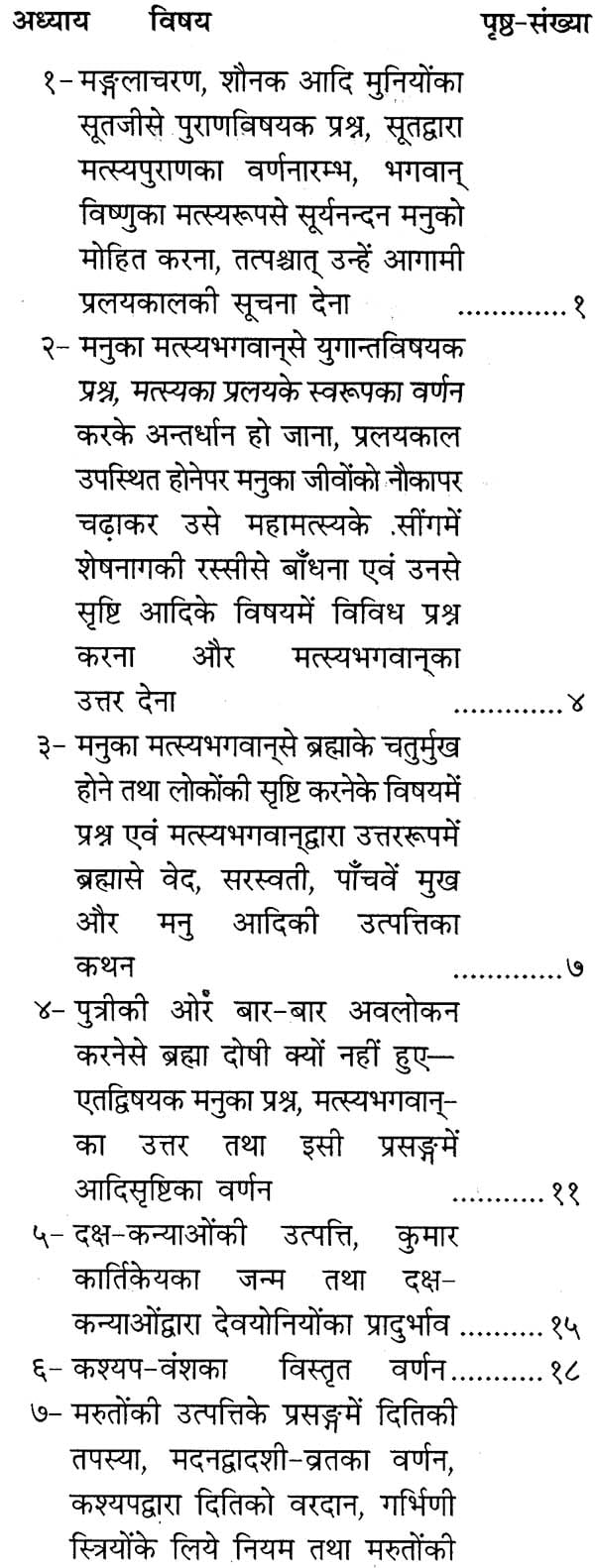Matsya Purana English Pdf

The Matsya Purana (IAST: Matsya Purāṇa) is one of the eighteen major Puranas (Mahapurana), and among the oldest and better preserved in the Puranic genre of Sanskrit literature in Hinduism. [1] [2] The text is a Vaishnavism text named after the half-human and half- fish avatar of Vishnu.

The Puranas are sacred texts which were composed many hundreds of years ago. There are many stories and rituals which form an integral part of Hinduism. Most of these are to be found in the Puranas. Together with the two epics, the Ramayana and the Mahabharata, the Puranas are read, revered and believed in. Thre are eighteen major Puranas or mahapuranas, the word maha, meaning great. There are also several other minor Puranas or upapuranas, the word upa signifying minor.
It is sometimes believed that the upapuranas are also eighteen in number. Amongst the eighteen mahapuranas, the Matsya Purana is number sixteen. This does not mean that it is sixteenth in order of important.
It just happens to be sixteenth in the list. The Puranas themselves describes the five characteristics (pancha lakshana) that a text must satisfy before being classified as a mahapurana. Digital physiognomy crack key. That is, any such text must describe five different subjects. These are the original creation of the universe (sarga), the periodical process of destruction and re-creation (pratisaryga), the various eras (manvantara), the histories of the solar dynasty (surya vamsha), and lunar dynasty (chandra vamsha) and royal genealogies (vamshanucharita). As you will see, the Matysa Purana does describe these five different subjects. Traditionally, the Ramayana is believed to have been composed by the sage Valmiki and the Mahabharata is believed to have been composed by the sage Vedavyasa. Vedavyasa was the son of Satyavati and the sage Parashara.
His real name was Krishna Dvaipayana. The word krishna means dark and he came to acquire the name because he was dark in complexion. The word dvipa means island and the sage acquired the name of Dvaipayana as he was born on an island. The Mahabharata has one lakh shlokas or couplets. It is believed that, after composing the Mahabharata.
Vedavyasa composed the eighteen mahapuranas. These texts have four lakh shlokas between them, although they are not equal in length. The Matsya Purana is a medium-length Purana, is comprises of fifteen thousand couplets. The longest Purana, the Skanda Purana, has eighty-one thousand. And the shortest Purana, the Markandeya Purana, has only nine thousand. The fourteen thousand shlokas of the Maysya Purana are divided into two hundred and ninety-one chapters (adhyaya). The eighteen mahapuranas are sometimes divided into three groups, with six Puranas in each group.
There are many gods in the Hindu pantheon. But the primary gods are Brahma, Vishnu and Shiva.
Brahma is regarded as the creator, Vishnu as the preserver, and Shiva as the destroyer. Since all three are important gods, any sacred text will glorify each of them.
But the relative emphasis often varies from text to text. For example, a text which spends many chapters on the act of creation tends to glorify Brahma relatively more and is known as a rajasika Purana. A text which describes the incarnations (avatara) of Vishnu in great detail tends to glorify Vishnu more and is known as a sattvika Purana. A text reoccupies with rituals and norms tends to attach more importance to Shiva and is known as a tamasika Purana. The Matsya Purana is regarded as a tamasika Purana. The five others in this group are.
The Kurma Purana, the Linga Purana, the Shiva Purana, the Skanda Purana and the Agni Purana. Although we have mentioned this classification, it is also fair to point out that the classification is slightly artifical. You now ought to be told why the Matsya Purana has such a name. The word matsya means fish. Usually Vishnu is regarded as having had nine incarnations, with a tenth one, Kalki, due to come in the future. The names of these incarnations are as follows.
(i) Matsya or fish. This is sometimes also referred to as the mina (fish) avatara.
(ii) Kurma or turtle. (iii) Varaha or boar. (iv) Nrisimha or narasimha, the half-man and half-lion. (v) Vamana or dwarf. (vi) Parashurama. (vii) Rama (viii) Krishna (ix) Buddha (x) Kalki.
This is sometimes also referred to as Kali. The Matsya Purana is so named because it was first recited by Vishnu himself, in his incarnation of a fish. We have referred to the belief that Vedavyasa composed all the mahapuranas. (There is no such general belief regarding the upapauranas.) No scholar however believes that a single individual could have composed all these texts. What Vedavyasa might have done is to have composed an original text known as the Purana samhita. This he taught to this chief disciple, Lomaharshana or Romaharshana.